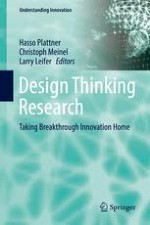2016 | OriginalPaper | Chapter
On Creating Workspaces for a Team of Teams: Learnings from a Case Study
Authors : Marie Klooker, Claudia Nicolai, Stephan Matzdorf, Arne Trost, Karen von Schmieden, Lilith Böttcher, Ulrich Weinberg
Published in: Design Thinking Research
Publisher: Springer International Publishing
Activate our intelligent search to find suitable subject content or patents.
Select sections of text to find matching patents with Artificial Intelligence. powered by
Select sections of text to find additional relevant content using AI-assisted search. powered by
